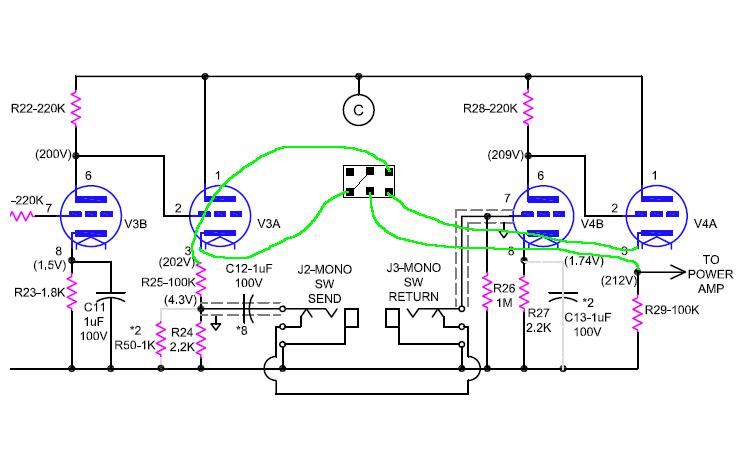Hello GDIY,
I’m trying to understand this tube effects loop circuit design from a Soldano super lead 60 amplifier.
Especially the return section where the signal inputs straight to the cathode of 1/2 12AX7 tube.
I never saw this type of montage before in a tube circuit.
I did search « cathode input tube preamp circuits » with no luck.
Questions:
-Is this common ? (Any other exemple circuits someone can share for reference?)
-Does this circuit have a name and what is it called?
-What happens when signal is fed direct to a cathode of a tube and out from the anode? Polarity? Gain?
-and if the grid was left unconnected ?
also, regarding the send/output section of tube effects loop circuits, I sometimes see both cathode follower and common cathode circuits. In which case/senario one would favor one over the other ?
effects loop circuit schematic attached for reference.

Thank you!
I’m trying to understand this tube effects loop circuit design from a Soldano super lead 60 amplifier.
Especially the return section where the signal inputs straight to the cathode of 1/2 12AX7 tube.
I never saw this type of montage before in a tube circuit.
I did search « cathode input tube preamp circuits » with no luck.
Questions:
-Is this common ? (Any other exemple circuits someone can share for reference?)
-Does this circuit have a name and what is it called?
-What happens when signal is fed direct to a cathode of a tube and out from the anode? Polarity? Gain?
-and if the grid was left unconnected ?
also, regarding the send/output section of tube effects loop circuits, I sometimes see both cathode follower and common cathode circuits. In which case/senario one would favor one over the other ?
effects loop circuit schematic attached for reference.

Thank you!



